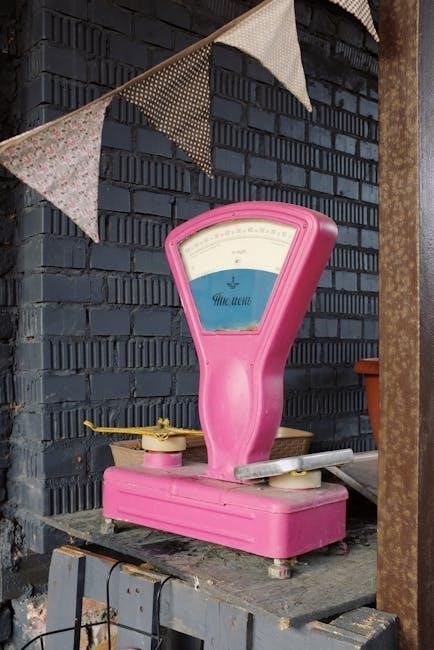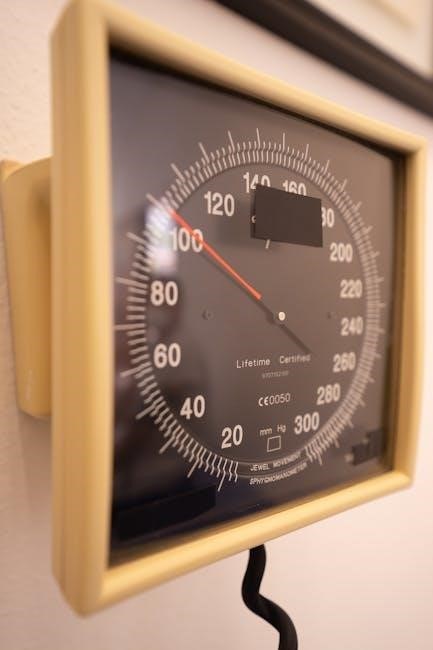The Seventh Edition by Richard S. Figliola and Donald E. Beasley provides a comprehensive guide to test system modeling, uncertainty analysis, and interactive problem-solving in mechanical measurements.
Overview of Mechanical Measurements
Mechanical measurements involve the quantification of physical parameters like displacement, velocity, force, and temperature. The Theory and Design for Mechanical Measurements, 7th Edition by Richard S. Figliola and Donald E. Beasley provides a foundational understanding of these concepts. It covers calibration, uncertainty analysis, and the integration of statistics in measurement design. The text emphasizes test system modeling and the development of test plans, ensuring accuracy and reliability in engineering applications. By focusing on both theoretical principles and practical implementation, this resource serves as a comprehensive guide for students and professionals in mechanical engineering and related fields, fostering an intuitive approach to solving real-world measurement challenges.
Importance of Mechanical Measurements in Engineering
Mechanical measurements are crucial in engineering for ensuring accuracy, reliability, and safety in design and analysis. The Theory and Design for Mechanical Measurements, 7th Edition highlights their role in validating theoretical models and optimizing system performance. By quantifying parameters such as force, displacement, and temperature, engineers can make informed decisions, troubleshoot issues, and innovate. The integration of measurement systems in research and industry underscores their significance in maintaining quality standards and advancing technological developments. This text emphasizes how precise measurements contribute to problem-solving and innovation, making them indispensable in modern engineering practices and applications.
Evolution of Measurement Techniques
The evolution of measurement techniques has transformed engineering practices, shifting from basic analog methods to sophisticated digital systems. The Theory and Design for Mechanical Measurements, 7th Edition highlights advancements in sensor technology, data acquisition, and signal processing. These innovations enable precise, real-time measurements, enhancing accuracy and reliability. Historical developments, such as calibration and error analysis, laid the groundwork for modern tools like digital transducers and software-driven systems. This progression ensures engineers can address complex challenges with improved confidence, reflecting how measurement techniques adapt to technological advancements and industry demands, as detailed in the textbook.

Theoretical Foundations of Mechanical Measurements
The textbook establishes core principles of measurement systems, emphasizing uncertainty analysis, calibration, and statistics. It provides a robust framework for understanding mechanical measurements through test system modeling and data analysis.

Basic Principles of Measurement Systems
Measurement systems rely on principles of accuracy, precision, and calibration to ensure reliable data acquisition. The Seventh Edition emphasizes test system modeling and uncertainty analysis, providing a structured approach to designing measurement systems. Key concepts include understanding sensor dynamics, signal conditioning, and data interpretation. The text also highlights the importance of statistical methods in validating measurements. By integrating theoretical knowledge with practical applications, the book equips engineers to develop robust measurement systems. These principles form the backbone of modern mechanical measurements, enabling precise and repeatable results in various engineering applications. The content is tailored to enhance both theoretical understanding and hands-on problem-solving skills.
Measurement Uncertainty and Error Analysis
Measurement uncertainty and error analysis are critical in ensuring the reliability of mechanical measurements. The Seventh Edition emphasizes the importance of quantifying uncertainty through statistical methods and understanding its impact on measurement results. Error sources, such as instrument limitations and environmental factors, are systematically identified and analyzed. The book provides practical techniques for minimizing errors and improving measurement accuracy. By integrating uncertainty analysis into the design of measurement systems, engineers can ensure more precise and reliable data collection. This section underscores the necessity of understanding and mitigating errors to enhance the overall quality of mechanical measurements in various engineering applications. The content is designed to provide a clear framework for implementing robust uncertainty analysis.
Calibration and Accuracy in Measurements
Calibration and accuracy are essential for ensuring the reliability of measurement systems. The Seventh Edition highlights the importance of calibration in establishing instrument accuracy across varying conditions. It explains methods to maintain calibration standards and adjust instruments for precise measurements. The text emphasizes how calibration ensures instruments operate within specified ranges, reducing errors. Accuracy is achieved by comparing measurements to known standards, ensuring data consistency. The book provides guidelines for routine calibration and validation, stressings its role in maintaining measurement integrity. By focusing on calibration and accuracy, engineers can trust their data, leading to better decision-making in design and analysis. This section is vital for understanding how to implement effective calibration practices.

Design Aspects of Mechanical Measurements
The Seventh Edition integrates design elements for measurement systems, focusing on test system modeling, uncertainty analysis, and test plan development with statistical applications.
Design of Measurement Systems
The Seventh Edition emphasizes the design of measurement systems, focusing on test system modeling, uncertainty analysis, and the integration of statistics in test plan development. It provides a comprehensive approach to designing accurate and reliable systems, ensuring precision and minimizing errors. The book offers practical examples and interactive problems to enhance understanding. By emphasizing statistical tools, it equips engineers with the skills to optimize measurement systems for real-world applications, ensuring robust and efficient designs.
Test Plan Development and Execution
The Seventh Edition thoroughly addresses the structured approach to test plan development, ensuring clarity and precision in experimental design. It emphasizes the importance of defining objectives, selecting appropriate measurement tools, and validating data collection methods. The book provides detailed guidance on executing test plans, including statistical tools for analyzing results and ensuring accuracy. Practical examples and interactive content help students grasp the complexities of test execution, enabling them to apply these concepts effectively in real-world engineering scenarios. This comprehensive coverage equips professionals with the skills to design and implement robust test plans, ensuring reliable outcomes in mechanical measurements.
Role of Statistics in Measurement Design
Statistics play a pivotal role in the design and analysis of mechanical measurements, as emphasized in the Seventh Edition. The text integrates statistical methods to validate data, reduce variability, and ensure reliable results. It explores techniques like hypothesis testing and confidence intervals to enhance the accuracy of experiments. The book also highlights the importance of statistical tools in experiment design, enabling engineers to make informed decisions. Practical examples and interactive content help students apply statistical concepts effectively. By leveraging statistics, professionals can optimize measurement systems, minimize errors, and improve overall experimental outcomes. This comprehensive approach ensures that statistical principles are seamlessly integrated into the design process.

Uncertainty Analysis in Mechanical Measurements
The Seventh Edition provides tools for quantifying and managing uncertainty, ensuring accurate and reliable results in mechanical measurements, with applications in engineering and experimental design.
Quantifying Uncertainty in Measurements
Quantifying uncertainty involves determining the range of possible values within which the true value of a measured quantity lies. This process is essential for ensuring the reliability and accuracy of experimental results. In the Seventh Edition of Theory and Design for Mechanical Measurements, methods for uncertainty quantification are explored, emphasizing statistical techniques and error analysis. The book highlights the importance of calibration and the role of uncertainty propagation in complex systems. By understanding and quantifying uncertainty, engineers can design more robust measurement systems and interpret data with confidence. This section provides a foundational understanding of how to apply these principles in real-world engineering applications.

Propagation of Uncertainty in Engineering Applications
Propagation of uncertainty refers to how errors in individual measurements affect the overall result of a calculation or system. In engineering applications, understanding this concept is crucial for designing reliable systems and interpreting experimental data. The Seventh Edition of Theory and Design for Mechanical Measurements provides detailed methods for propagating uncertainty, emphasizing the use of statistical techniques and sensitivity analysis. By quantifying how errors in input variables affect output results, engineers can identify critical parameters and optimize system performance. This ensures that designs are robust and data interpretation is accurate, ultimately enhancing the credibility of engineering solutions in real-world scenarios.
Uncertainty and Confidence Intervals
Uncertainty in measurements is often expressed using confidence intervals, which provide a range of values within which the true value lies with a specified probability. The Seventh Edition emphasizes the importance of statistical methods in determining these intervals, allowing engineers to quantify and communicate the reliability of their measurements. Confidence intervals are essential in engineering applications, as they enable professionals to make informed decisions based on experimental data. The book integrates practical examples and case studies to illustrate how uncertainty analysis, including confidence intervals, ensures accurate and reliable results in mechanical measurements, bridging theory with real-world applications.

Practical Considerations in Mechanical Measurements
Practical challenges include sensor selection, data acquisition, and environmental factors like temperature. Calibration ensures accuracy, while statistics aid in uncertainty analysis, addressing real-world measurement complexities effectively.
Selection of Sensors and Transducers

Selecting appropriate sensors and transducers is critical for accurate mechanical measurements. Factors such as accuracy, sensitivity, and operating range must align with the measurement objective. Environmental conditions, like temperature and vibration, can influence sensor performance. Calibration ensures sensors provide reliable data, while statistics help quantify uncertainty. Modern sensors integrate seamlessly with digital systems, enhancing data acquisition. The Seventh Edition emphasizes the importance of test system modeling and uncertainty analysis in sensor selection, ensuring robust measurement systems. Proper sensor choice minimizes errors and optimizes system reliability, making it a cornerstone of effective mechanical measurement design.
Data Acquisition Systems and Signal Conditioning
Data acquisition systems (DAS) are essential for capturing and processing measurement data. They convert analog signals from sensors into digital formats for analysis. Signal conditioning enhances signal quality by amplification, filtering, and isolation, ensuring accurate data transmission. The Seventh Edition highlights the integration of DAS with modern digital systems, emphasizing their role in test system modeling. Proper signal conditioning minimizes noise and interference, while DAS ensures high-fidelity data capture. Advanced systems leverage interactive tools for real-time analysis, enhancing measurement precision. This integration is crucial for addressing practical challenges in mechanical measurements, as outlined in the text, and supports robust uncertainty analysis in engineering applications.
Practical Challenges in Real-World Measurements
Real-world measurements face challenges like noise, interference, and environmental factors that can degrade signal quality. Temperature fluctuations and humidity often introduce errors, requiring precise calibration and robust signal conditioning. Additionally, sensor limitations, such as nonlinear responses, complicate data accuracy. The Seventh Edition emphasizes the importance of addressing these challenges through advanced uncertainty analysis and statistical tools. By integrating these methods, engineers can mitigate errors and improve measurement reliability. Practical challenges highlight the need for careful test plan design and system modeling to ensure precise and repeatable results in dynamic environments. These considerations are vital for achieving accurate mechanical measurements in industrial and research settings.

Modern Developments in Mechanical Measurements
The 7th Edition highlights advances in sensor technology and digital integration, enabling precise measurements. Modern tools like uncertainty analysis and interactive systems enhance accuracy and efficiency in engineering applications.
Advances in Sensor Technology
Recent advancements in sensor technology, as detailed in the 7th Edition, include the development of digital sensors, MEMS (Micro-Electro-Mechanical Systems), and smart sensors. These innovations enhance accuracy, reduce noise, and enable real-time data processing. Modern sensors integrate seamlessly with digital systems, improving measurement precision and reliability. The integration of IoT (Internet of Things) capabilities allows for remote monitoring and data transmission, expanding the scope of mechanical measurements. New materials and miniaturization techniques have also led to more versatile and cost-effective sensing solutions. These advancements are critical in addressing complex engineering challenges, ensuring higher performance and efficiency in various applications. The book emphasizes their role in test system modeling and uncertainty analysis.
Integration of Digital Systems in Measurements
The integration of digital systems in measurements has revolutionized the field, enabling precise data acquisition and analysis. Modern digital systems, as discussed in the 7th Edition, incorporate advanced sensors, data acquisition software, and real-time processing capabilities. These systems enhance accuracy by minimizing signal noise and enabling high-speed data sampling. Digital tools also facilitate the integration of measurement systems with broader engineering applications, improving overall system efficiency. The use of digital systems supports robust uncertainty analysis and test plan design, ensuring reliable results. Additionally, interactive digital platforms in the e-book format engage students with hands-on learning opportunities, fostering a deeper understanding of measurement principles and their practical applications in engineering contexts.
Future Trends in Mechanical Measurements
Future trends in mechanical measurements emphasize the integration of advanced technologies like AI, IoT, and cloud computing to enhance precision and efficiency. The 7th Edition highlights the growing importance of smart sensors and wireless communication in measurement systems. Miniaturization of sensors and the development of energy-efficient devices are expected to drive innovation. Additionally, the adoption of machine learning algorithms for data analysis will improve uncertainty quantification and real-time decision-making. Sustainability-focused measurements, such as energy harvesting sensors, are also gaining traction. These advancements will enable engineers to design more robust and adaptive measurement systems, ensuring higher accuracy and reliability in diverse engineering applications. The fusion of hardware and software will continue to redefine the field.

Case Studies and Applications
The 7th Edition illustrates practical applications of measurement systems in aerospace, automotive, and industrial engineering, showcasing real-world test plans and uncertainty analyses for diverse engineering challenges.
Real-World Applications of Measurement Systems
In the 7th Edition, Figliola and Beasley highlight real-world applications across industries, such as aerospace and automotive engineering, demonstrating how measurement systems are integral to product development and quality control. Case studies show how engineers use test system modeling to optimize performance and reduce errors. The book emphasizes the role of uncertainty analysis in ensuring data reliability, which is critical in high-stakes environments like rocket propulsion and vehicle safety testing. By integrating practical examples with theoretical concepts, the text bridges the gap between classroom learning and industrial applications, preparing students for real-world challenges in mechanical measurements.
Case Studies in Industrial Measurements
The 7th Edition includes case studies from various industries, such as aerospace and automotive, showcasing how measurement systems solve real-world problems. These examples highlight the application of test system modeling and uncertainty analysis in optimizing industrial processes. For instance, one case study demonstrates how engineers reduced manufacturing defects by implementing precise measurement protocols. Another illustrates the use of statistical tools to improve quality control in production lines. These practical examples provide insights into overcoming challenges like noise reduction and sensor calibration. By linking theory to practice, the text prepares students to tackle complex measurement challenges in diverse industrial environments, emphasizing the importance of accurate data acquisition and analysis.
Measurement Systems in Research and Development
In research and development, advanced measurement systems play a pivotal role in innovation and experimentation. The 7th Edition emphasizes how these systems are integrated into R&D workflows, enabling precise data collection and analysis. The book highlights the use of test system modeling and uncertainty analysis in experimental setups, ensuring reliable results. Case studies demonstrate how engineers leverage sensor technology and digital integration to optimize product designs. By combining theoretical concepts with practical applications, the text equips researchers with tools to enhance measurement accuracy and efficiency, driving advancements across various engineering fields. This focus on innovation underscores the importance of measurement systems in achieving R&D objectives and fostering technological progress.
The 7th Edition of Theory and Design for Mechanical Measurements provides a comprehensive understanding of measurement systems, uncertainty analysis, and test design, enhancing engineering applications and research.
References and Further Reading
Figliola, R. S., & Beasley, D. E. (2019). Theory and Design for Mechanical Measurements (7th ed.). Wiley. ISBN: 9781119495192.
The 7th Edition of Theory and Design for Mechanical Measurements emphasizes foundational principles, test system modeling, and uncertainty analysis. It integrates measurement theory with practical applications, focusing on the design of measurement systems and test plans. The text highlights the role of statistics in ensuring accuracy and reliability. By leveraging interactive digital tools, it enhances student engagement and understanding. The book serves as a vital resource for both students and professionals, providing comprehensive insights into modern mechanical measurement techniques and their real-world applications in engineering and research.
For in-depth study, Theory and Design for Mechanical Measurements, 7th Edition by Richard S; Figliola and Donald E. Beasley is a primary reference; Published by Wiley in 2019, this 592-page textbook (ISBN: 1119495199) provides detailed insights into measurement theory, test system modeling, and uncertainty analysis. Additional resources include Montgomery’s Design and Analysis of Experiments, 7th Edition, which complements the statistical aspects of measurement design. Readers are encouraged to explore these texts for a comprehensive understanding of mechanical measurements and their practical applications in engineering and research.
